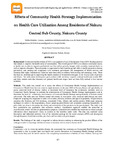Effects of Community Health Strategy Implementation on Health Care Utilization Among Residents of Nakuru Central Sub County, Nakuru County

View/
Date
2017Author
Kwasira, Tabitha Mukolwe
Makind, Stanley
Some, Eliab
Muchiri, Joseph
Metadata
Show full item recordAbstract
Background: Community health strategy (CHS) is an approach of one of the Kenyan Vision 2030 flagship projects
that intends to improve the health status of communities. The overall goal of CHS is to enhance community access
to health care in order to improve productivity and thus reduce poverty, hunger, child mortality, maternal death, as
well as improve education. The community is empowered to have knowledge and skills in health promotion, disease
prevention, care seeking and compliance with treatment, governance and management of health services and
claiming their rights. International initiatives have been taken to address both existing and emerging issues. There
has been no breakthrough in improving the health situation of households entrapped in the vicious cycle of poverty
and illness. The millennium development goals (reduce child mortality, improve maternal health and combat HIV
and Aids, malaria and other diseases) and primary health care targets have not been fully realised in low income
countries.
`
Methods: This study was carried out to assess the effects of Community Health Strategy Implementation on
Utilization of Health Care Services since its implementation in the year 2009 in Nakuru, Kenya and specifically, to
assess perceived level of disease burden, to determine level of awareness the community members have on
Community Health Strategy, to evaluate the achievements of Community Health Strategy implementation and to
determine the level of community involvement on Community Health Strategy among residents of Nakuru central
sub county. The study area was Nakuru central sub county. A descriptive- cross sectional study design was used.
Purposive sampling was employed to select sub counties, division, locations and age of respondents. Simple random
sampling (for locations and Sub locations, community Units, villages and starting points), Multi-stage sampling
technique (to arrive at the respondents), cluster sampling (plots/blocks) and systematic sampling (households). A
pilot study was done to determine the clarity and consistency of the questions in the questionnaire. The study used
both quantitative and qualitative data collection methods. Quantitative approach enabled the researcher to
systematically collect the data for generalization purposes. Qualitative data enabled the researcher to obtain in-depth
information about respondent’s views in relation to the variables under study. The data was analyzed using
descriptive and inferential statistics. Use of the statistical package for the social sciences (SPSS) and description
through frequency distributions tables, pie charts and bar charts and percentages).
Results: The findings of the study is expected to inform decision making in enhancing the positive Effects of the
strategy in order to encourage initiation of more community units to reverse disease trends.
Conclusion:
Community is yet to overcome malaria disease, the community has awareness on Community Health Strategy, the
community is able to control their own health and involve themselves in Community Health Strategy activities.
They ensure they seek for health services like completing immunization schedules of their children, treating theirdrinking water by boiling, adding disinfectants to avoid infections transmitted through water. They participate in
wash activities by washing hands after toilet and use various means such as washing hands on running tap, placing
tilt tins outside the toilets and fill with water and using water jag. They utilize government health facilities as
directed in the strategy, consequently influencing behaviours from bad to healthy behaviours
Collections
- MKSU Doctoral Theses [51]
